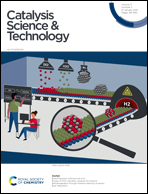First principles studies of mononuclear and dinuclear Pacman complexes for electrocatalytic reduction of CO2†
Abstract
The electrochemical reduction of carbon dioxide (CO2) generating value-added chemicals or fuels using renewable energy resources represents a promising approach to mitigate the greenhouse gases present in the atmosphere. However, a critical challenge to this approach is to develop highly efficient catalysts with minimum energy input and maximum conversion efficiency. Stable and strong electrocatalysts, which can promote the electroreduction of CO2 beyond the two-electron process to produce various useful products, are highly desirable. Herein, we studied mononuclear and dinuclear complexes of Cr, Mn, Fe, Co and Ni with macrocyclic Schiff-base calixpyrrole ligands, often referred to as Pacman ligands, for their activity towards catalysing the reduction of CO2 to methane (CH4) or methanol (CH3OH). In the case of mononuclear complexes, only one N4 cavity is occupied by the transition metal. In contrast, in the case of dinuclear complexes, the transition metal is placed in each of the two N4 cavities of the macrocyclic ligand. Our DFT calculations have shown that the iron-containing mononuclear complex displayed the highest activity and selectivity for the transformation of CO2 to CH4 with a very low negative value of limiting potential of −0.24 V. However, in the case of dinuclear complexes, the lowest negative limiting potential was found to be −0.45 V. This work offers a technique for developing electrocatalysts that have great potential for CO2 reduction reactions.



 Please wait while we load your content...
Please wait while we load your content...